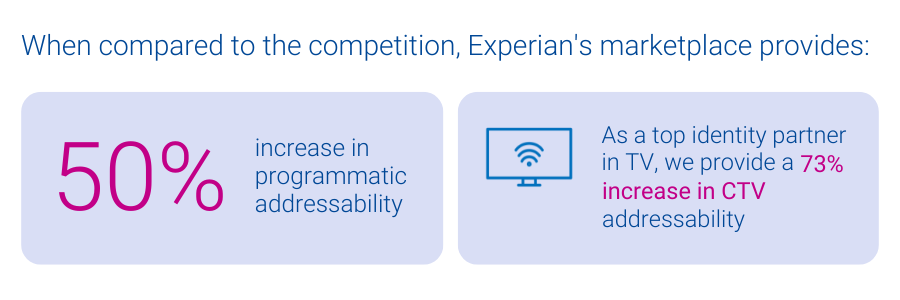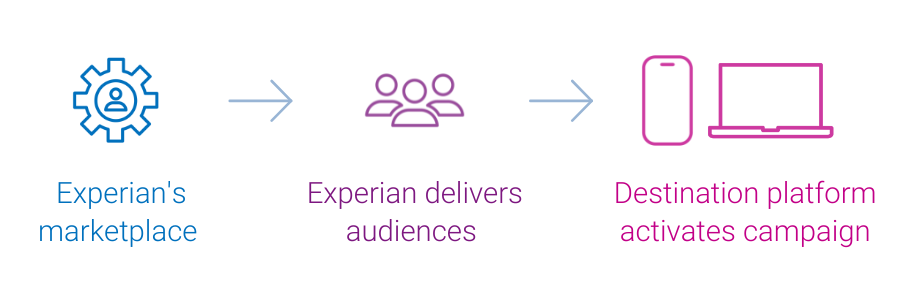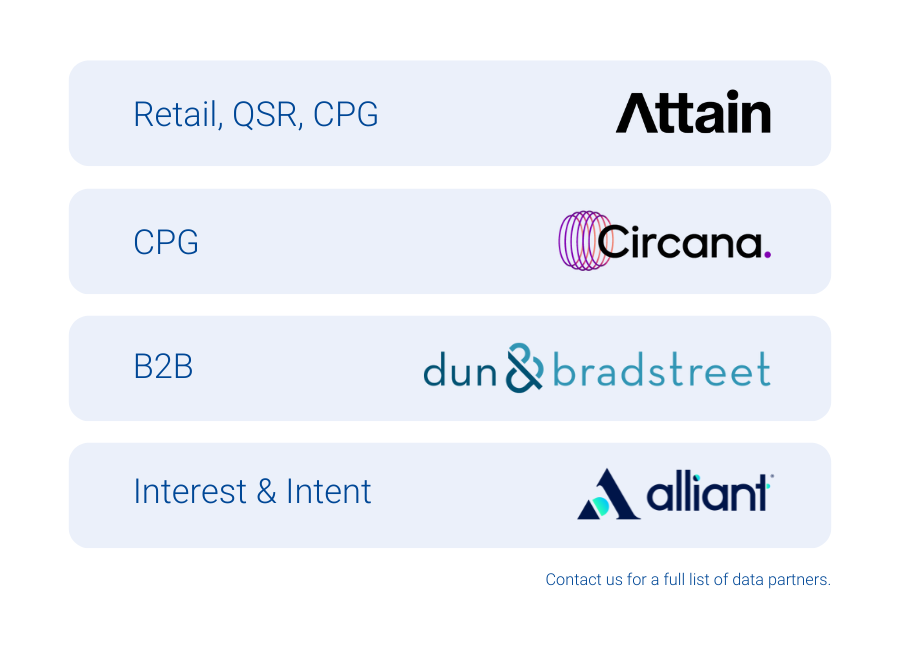
In a perfect world, we’d all have a single, go-to grocery store that carried everything on our shopping list – fresh produce, gourmet coffee beans, rare spices, and maybe even that special-grade olive oil, right alongside our wholesale bulk purchases at unbeatable prices. It would be convenient and efficient, and it’d save a lot of driving around town.
The changing data marketplace: From one-stop shop to specialized selection
For a long time, data buyers enjoyed something similar in their world: a small set of large-scale data marketplaces that offered a wide array of audiences, making it easy to load up on whatever you needed in one place. Not only are there fewer places to pick everything up, but new factors like privacy and signal deprecation are placing a spotlight on quality and addressability.
Just as our dinner plans are growing more ambitious insofar as we want health, flavor, value, and convenience all in one place – so are our data strategies. Instead of a single steak-and-potatoes meal, today’s data marketplace operators might be cooking up a complex menu of campaigns.
“Experian has been a longstanding partner of DISH Media, and we’re excited to be an early adopter of their marketplace which leverages the foundation of their identity solutions to ensure maximum cross-channel reach as we look to expand the breadth and depth of data we use for addressable TV.”
Kemal Bokhari, Head of Data, Measurement & Analytics, DISH Media
As a result, data buyers are beginning to shop around. Some still rely on large-scale marketplaces for familiar staples, but now they have reasons to explore other options. Some are turning to providers known for offering top-tier, transparently sourced segments. Others are focusing on specialty providers that excel in one area.
A more selective approach to data buying
In this environment, choosing where to “shop” for data is becoming more deliberate and selective. Data buyers aren’t just thinking about broad scale; they’re looking to prioritize quality, durability, data privacy, and differentiation. They need to place higher value on data marketplaces that can maintain audience addressability over time, despite signal loss. Sometimes, that means accepting a smaller assortment in exchange for tighter vetting and more reliable targeting. Other times it means mixing and matching – stopping by one marketplace for premium segments and another for cost-friendly, wide-reaching data sets. Either way, they can benefit from having more choices.
“Experian has been a longstanding partner of DISH Media, and we’re excited to be an early adopter of their marketplace which leverages the foundation of their identity solutions to ensure maximum cross-channel reach as we look to expand the breadth and depth of data we use for addressable TV.”
Kemal Bokhari, Head of Data, Measurement & Analytics, DISH Media
Experian’s marketplace: A trusted source for high-quality data
Experian’s vetted and curated blend of data partners and vertically-aligned audiences offers a trusted specialty store for data buyers. Experian’s marketplace, powered by identity graphs that include 126 million households, 250 million individuals, and 4 billion active digital IDs, enables partner audiences to be easily activated and maintain high addressability across display, mobile, and connected TV (CTV) channels. In particular, Experian’s marketplace provides:


The future of data marketplaces: Precision and flexibility matter
The evolution of data marketplaces reflects the industry’s shifting priorities. Data buyers seek specificity, reliability, and adaptability to align with their diverse campaign needs. The best data strategy, much like the best grocery run, isn’t about grabbing everything in one place – it’s about carefully selecting the right ingredients to create the perfect recipe for success. This shift underscores the importance of flexibility and precision as data buyers navigate a landscape shaped by privacy regulations, signal loss, and evolving consumer expectations.

As data marketplaces adapt to meet these demands, they are redefining what it means to deliver value. Experian’s marketplace enables buyers to strike the perfect balance between reach and quality by offering enhanced match rates, precise audience planning, and seamless distribution. In this new era, data buyers have the tools and options to craft campaigns that are impactful and aligned with the increasingly selective and privacy-conscious digital landscape. The key is recognizing that today’s data strategy is about utilizing the strengths of many to create a cohesive and effective whole.
If you’re interested in learning more about Experian’s marketplace or becoming an active buyer or seller in our marketplace, please contact us.
Latest posts

At the recent Beet Retreat 2023 in Santa Monica, a fireside chat featuring Kimberly Gilberti, Experian’s Chief Product Officer, shed light on how connected TV (CTV) is changing content delivery and introducing a profound shift in audience engagement and advertising strategies. In this blog post, we’ll recap Gilberti’s discussion about advertising on CTV. CTV's transformative impact on media consumption CTV brings together the nostalgia of traditional television and the cutting-edge capabilities of digital targeting, opening new doors for advertisers to connect more meaningfully with audiences. This integration heralds a new wave of viewer engagement opportunities. The revolution goes beyond altering content consumption modes; it fundamentally transforms how audiences interact with media. Advertisers now have the tools to forge deeper, more personalized connections with their audience, thanks to CTV. "The evolution of media is exciting, offering endless opportunities due to the vast inventory and engaged audiences. The key to using this is understanding the consumer, the 'who' behind the viewing."kimberly gilberti, chief product officer The evolution of advertising on CTV In CTV, traditional advertising strategies are being re-evaluated. Advertisers must pivot to meet changing viewer trends, focusing on campaigns that resonate on a personal level and harness the targeted delivery capabilities of the medium. Data and technology stand at the forefront of advertising on CTV. Effective collection, analysis, and application of audience data are crucial for creating impactful CTV campaigns. Advanced analytics tools are essential in deciphering complex viewer habits. Companies like Experian are key players, offering the necessary tools and insights for advertisers to navigate the CTV space effectively. "Experian's unique data assets are incredibly valuable. We understand consumers wherever they are, connecting the offline and online worlds. Our database, rooted in real people's information, is extensive and privacy-focused, covering virtually every U.S. household."kimberly gilberti, chief product officer The complexities and opportunities in advertising on CTV Even though the CTV landscape is filled with vast opportunities and significant challenges, one major hurdle is accurately identifying viewers within shared household accounts, complicating targeted advertising on CTV efforts. Additionally, the fragmentation of content across multiple streaming platforms amplifies the challenge of reaching specific audience segments. The presence of 'walled gardens' adds another layer of complexity in achieving a comprehensive understanding of audience behavior across different platforms. Despite these challenges, the potential for effective, personalized advertising on CTV is immense. Key to unlocking this potential is the accurate measurement of ROI and the alignment of content with viewer preferences. These areas of focus underscore the need for sophisticated identity resolution and audience analysis solutions. Collaboration is the key to unlocking CTV's potential The future of advertising on CTV relies on collaboration. Joint efforts from advertisers, agencies, technology providers, and publishers are essential for sharing data and insights while maintaining consumer privacy. This collective approach is pivotal in tackling the challenges of advertising on CTV and harnessing its full potential. As the industry dives deeper into the CTV landscape, insights from Beet Retreat 2023 and leaders like Gilberti underscore the importance of understanding and engaging with your consumers. The collaborative efforts of the industry, bolstered by technological and data-driven expertise, are critical in capitalizing on the power of CTV. Experian’s Collaboration solution connects our client's and partner's data to unlock more robust insights, smarter activation, and more holistic measurement for online and offline media efforts. To learn more about what our data collaboration services can do for your business in this new era of CTV, visit our website or connect with a member of our team today. Start collaborating with Experian Latest posts

In the fast-paced advertising world, collaboration is crucial to keep up with the flux in consumer behaviors. Samsung Ads and Experian have joined forces to address this challenge. This partnership aims to equip marketers with the necessary tools and insights to create compelling and impactful content that resonates with the right audience at the right time. By combining our expertise and precision, through this new partnership, we promise to maximize the reach, effectiveness, and efficiency of advertising campaigns. This collaboration ensures that marketing messages get noticed and strike a chord with the intended audience, leading to meaningful engagement and measurable outcomes. The Samsung Ads and Experian collaboration The powerful integration between Samsung Ads and Experian brings together Samsung Ads’ industry-leading viewership data and massive device scale with the detailed data insights of Experian. This combined effort enhances the effectiveness of advertising campaigns by merging scale with precision. Advertisers can now reap the benefits of a comprehensive solution that delivers customized content to a wide audience with unparalleled accuracy. “Navigating the dynamic landscape of digital advertising requires innovative solutions and strategic collaborations. This partnership with Samsung Ads exemplifies our commitment to empowering advertisers with data-driven insights that reach and resonate with audiences. With Experian Marketing Data directly accessible within the Samsung DSP, advertisers are equipped to orchestrate campaigns with unprecedented precision and impact, marking a significant stride in personalized advertising." chris feo, svp, sales & partnerships, experian Samsung Ads: Orchestrating reach and precision Samsung Ads’ suite of advertising solutions uses Samsung’s massive global scale to bring advertisers unmatched opportunities to engage consumers across every screen, during every moment that matters, delivering quantifiable results on a massive scale. Samsung DSP: Key features and benefits Samsung Ads believes that smarter advertising doesn’t need to be more complicated. With Samsung DSP, every intuitive feature is engineered to make media simple again, offering advertisers the ability to reach their audience more effectively, across every screen. Addressable TV Transforms traditional viewing experiences by delivering personalized content to specific households, enhancing engagement and connection. Contextual targeting Nurtures audience engagement by placing ads in relevant content environments that amplify their relevance and impact. Global reach Navigate the digital expanse with agility, delivering content to millions of consumers across devices and platforms, in brand-safe environments. Data-driven targeting Combine Samsung Ads' unrivaled proprietary device data with Experian's insights, to translate global reach into personalized consumer engagement. “The new partnership between Experian and Samsung Ads is an exciting development for advertisers as they look to maximize the effectiveness of their marketing campaigns. With hands-on access to Experian’s identity solution and audiences directly within our platform, Samsung DSP, advertisers can now better address their most important audiences on the screens they use most.”alex boras, platform lead, samsung dsp Why choose Experian in Samsung At Experian, data is more than just numbers; it tells detailed stories about what consumers like, how they behave, and their experiences. Each piece of data supports the connective networks that offer advertisers nuanced insights and actionable strategies. Ease of use Experian syndicated audiences take the guesswork out of developing segments, and they are available turnkey on the Samsung Ads shelf. Expansive reach, scale, and flexibility Our breadth and depth of data ensures detailed and targeted insights, spanning multiple verticals and can be directly attached to households, providing contextual relevance to each consumer's behaviors and purchase patterns. A rich data set that encompasses 126 million households and 750 million hashed emails 5,000 data attributes for enrichment, licensing, and audience creation 2,400 ready-to-use audiences on integrated platforms spanning 8 verticals, complemented by an average of 2,300 attributes per household and 250 attributes per consumer Four benefits to advertisers The partnership between Samsung Ads and Experian offers a plethora of benefits to advertisers, including: Enhanced audience targeting You can use Samsung Ads' ACR data and Experian's syndicated audiences to create highly targeted campaigns that reach the right audience at the right time. This can lead to significant improvements in campaign performance, such as increased engagement, conversion rates, and ROI. Optimized ad spend You can reduce wasted ad spend by using Experian's data to identify and avoid audiences less likely to be interested in your products or services. This can help you get the most out of your advertising budget. Improved attribution You can better understand the consumer journey by tracking how audiences interact with your ads across different devices and platforms. This information can be used to optimize campaigns and improve overall performance. Brand safety You can ensure that your ads are displayed in safe and secure environments by using Samsung Ads' brand safety solutions. This helps to protect brand integrity and reputation. Samsung and Experian are steering the future of advertising Together, our goal is to bring personalized and improved ad experiences to the forefront. This partnership allows advertisers to tailor their ads to individual consumer interests and needs, using the rich consumer data insights provided by Experian. Additionally, the partnership offers measurable aspects that allow advertisers to assess the effectiveness of their campaigns across various platforms, increasing their return on investment. By enhancing the overall ad experience, Samsung and Experian ensure that ads are more relevant and less intrusive, improving consumer engagement. Connect with us to learn more about how you can access our syndicated audiences in Samsung’s DSP. To learn more about our partner Samsung Ads, visit SamsungAds.com. Latest posts

Industry leaders recently gathered at the influential Beet Retreat 2023 conference held in Santa Monica, sharing forward-looking perspectives on the future of advertising. This renowned event known for its diverse mix of leaders from TV, agencies, advertising, and technology sectors, was enriched by insights from Experian’s very own Chris Feo, SVP of Sales & Partnerships, and Kimberly Gilberti, Chief Product Officer. Both Feo and Gilberti brought their expertise and perspectives for harnessing the potential of high-growth connected TV (CTV) advertising. The era of connected everything at Beet Retreat 2023 In the “Era of Connected Everything,” panel, Feo dived into the concept of a ‘connected everything’ world. He emphasized the importance of balancing consumer and privacy expectations with the increasing integration of AI and machine learning. “As decisioning evolves, creative tech and data derived from creative scale will play a bigger role.”chris feo, svp, sales & partnerships Feo further discussed the potential of creative technology, particularly in how AI and machine learning could revolutionize content personalization. He cited examples where the same creative content is used indiscriminately across diverse demographics, suggesting a future where creative content adapts and performs well for a variety of audience identities. Experian's balanced approach at Beet Retreat 2023 During a fireside chat, Gilberti shared her vision on the transformative role of television in the advertising technology landscape. “Connecting exposure to business outcomes is the holy grail of measuring CTV and effectiveness.”kimberly gilberti, chief product officer Her insights reflected the growing interplay between digital and traditional TV advertising, and the opportunities arising from this convergence. Gilberti emphasized the critical role of data analytics in enabling advertisers to tailor content more effectively to diverse TV audiences. She envisioned a future where the integration of digital strategies and traditional TV advertising create a more cohesive and impactful AdTech approach. Future focus: Diversification and partnerships Both Feo and Gilberti underscored the need for advertisers to diversify their partnerships. By working with a variety of partners, you can mitigate risks and foster innovation, ensuring you are not overly dependent on a single channel or approach. Navigate what’s next with Experian Experian's contributions at Beat Retreat 2023 underscore our pivotal role in the AdTech industry. With a unique balance of offline and online data expertise, we are not just adapting to changes but leading the way in innovation and strategy. Our insights and approaches, as highlighted by Feo and Gilberti, demonstrate our commitment to guiding the industry through its rapid evolution, making our role indispensable in the future of advertising technology. At Experian, we’re your partner in data-driven marketing and can help make your interactions more meaningful. To learn more, connect with a member of our team today. Connect with us Latest posts